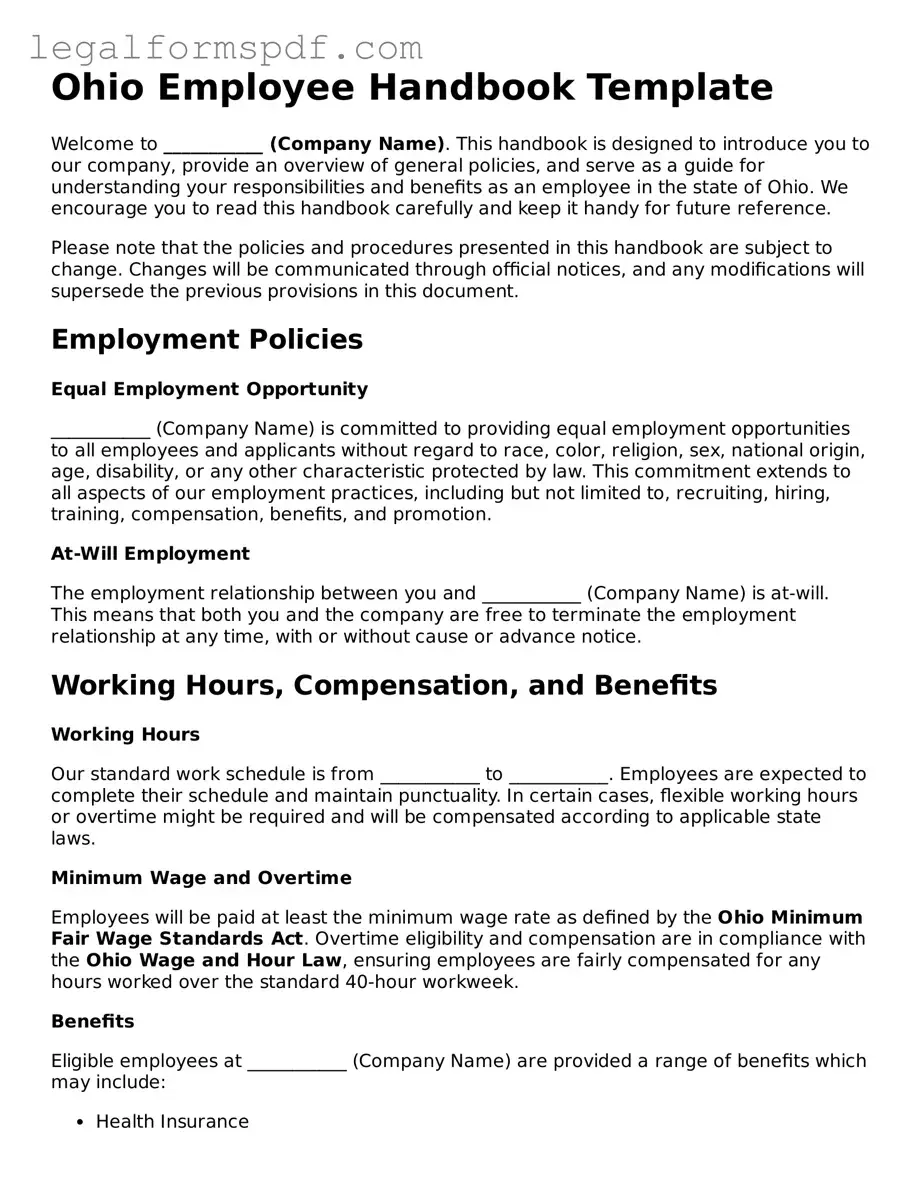Ohio Employee Handbook Template
Welcome to ___________ (Company Name). This handbook is designed to introduce you to our company, provide an overview of general policies, and serve as a guide for understanding your responsibilities and benefits as an employee in the state of Ohio. We encourage you to read this handbook carefully and keep it handy for future reference.
Please note that the policies and procedures presented in this handbook are subject to change. Changes will be communicated through official notices, and any modifications will supersede the previous provisions in this document.
Employment Policies
Equal Employment Opportunity
___________ (Company Name) is committed to providing equal employment opportunities to all employees and applicants without regard to race, color, religion, sex, national origin, age, disability, or any other characteristic protected by law. This commitment extends to all aspects of our employment practices, including but not limited to, recruiting, hiring, training, compensation, benefits, and promotion.
At-Will Employment
The employment relationship between you and ___________ (Company Name) is at-will. This means that both you and the company are free to terminate the employment relationship at any time, with or without cause or advance notice.
Working Hours, Compensation, and Benefits
Working Hours
Our standard work schedule is from ___________ to ___________. Employees are expected to complete their schedule and maintain punctuality. In certain cases, flexible working hours or overtime might be required and will be compensated according to applicable state laws.
Minimum Wage and Overtime
Employees will be paid at least the minimum wage rate as defined by the Ohio Minimum Fair Wage Standards Act. Overtime eligibility and compensation are in compliance with the Ohio Wage and Hour Law, ensuring employees are fairly compensated for any hours worked over the standard 40-hour workweek.
Benefits
Eligible employees at ___________ (Company Name) are provided a range of benefits which may include:
- Health Insurance
- Dental and Vision Coverage
- Life Insurance
- Retirement Plans
- Paid Time Off
Detailed information about eligibility, enrollment, and other specifics of these benefits programs will be provided separately or during orientation.
Leave Policies
Our company observes all applicable leave entitlements as required by state law, including but not limited to:
- Ohio Family and Medical Leave (OFMLA): Employees may be eligible for job-protected leave for certain family and medical reasons.
- Ohio Military Family Leave: Qualifying employees are entitled to leave for reasons related to military service of family members.
Workplace Policies
Drug and Alcohol Policy
___________ (Company Name) maintains a drug-free workplace. The use, possession, sale, or transfer of drugs or alcohol within the workplace or during work hours is strictly prohibited and may result in disciplinary action.
Harassment and Discrimination
Our company prohibits harassment and discrimination in any form. This policy applies to all employees, including managers, supervisors, co-workers, and non-employees such as customers, clients, and vendors. Any complaints of harassment or discrimination should be reported immediately to a supervisor or the Human Resources department for investigation and appropriate action.
Employee Acknowledgement
This handbook is intended to provide an overview of ___________ (Company Name)'s policies and procedures and is not intended to create a contract of employment. I acknowledge that I have received, read, and understand the content of this Ohio Employee Handbook. I recognize that it is my responsibility to adhere to the policies and guidelines outlined within and that non-compliance may result in disciplinary action, up to and including termination of employment.
Employee Name: ____________________________________
Date: ____________________________________
Signature: ____________________________________
